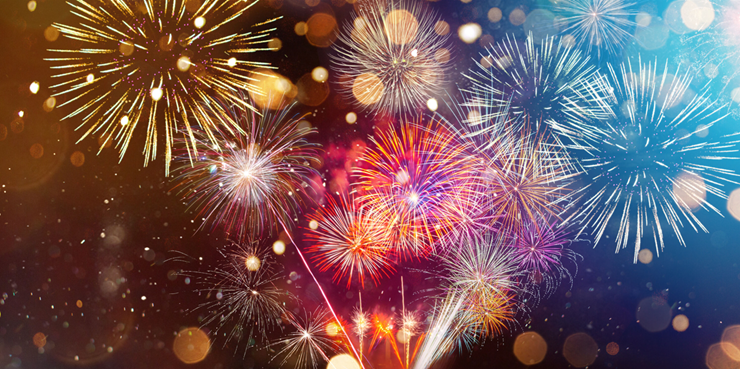Fireworks reduce air quality and cause noise pollution
Fireworks generate a lot of particles. They temporarily reduce the air quality, especially at the turn of the year in urban areas where there are a lot of fireworks. HSY and Tukes advise that the harm caused by fireworks can be lessened by observing the restrictions concerning the time and place for using them and by avoiding smoky places.

Fireworks are nice to look at, but they release fine particles that are harmful to health into the air we breathe.
Inhaling smoke from fireworks is harmful to your health
Fireworks contain a number of chemicals and metals to achieve their display of colours. When ejected into the air, the chemicals and metals turn into fine particles that reduce the air quality on the night of New Year’s Eve, especially if the weather is calm and freezing. In windy weather, air pollutants are diluted faster. The Helsinki Region Environmental Services Authority HSY monitors the air quality in the Helsinki Metropolitan Area, and the smoke from the firework displays during New Year’s can be seen especially in the air quality of the city centres as elevated concentrations of fine particles.
“In calm weather, the concentrations of fine particles can rise to very high levels on the night of New Year’s Eve; even up to 15–20 times higher than normal. Air quality is classified as poor if the hourly concentration of fine particles is 50 micrograms per hour. In Vantaa, for example, we have measured hourly concentrations of about 180 micrograms per cubic metre during New Year’s”, says Hanna Manninen, Head of Air Quality Unit at HSY.
The smoke from fireworks is not good for your health, so it should be avoided as much as possible. Consequently, people with asthma, other chronic respiratory conditions and coronary artery disease, as well as young children, should watch fireworks from a distance. High particle concentrations even in the short term can exacerbate chronic lung and heart conditions. Young children may also be more likely to develop respiratory symptoms, such as a cough, a sore throat and a runny nose, from the smoke than healthy adults.
“If you want to watch the fireworks, you should avoid places where there is visible smoke near the ground or where the air smells like smoke”, Manninen advises.
Fireworks consist of a number of different chemicals
The Finnish Safety and Chemicals Agency (Tukes) estimates that Finns launch hundreds of thousands of kilograms of fireworks into the sky at the turn of the year. In terms of unit numbers, this means millions of individual fireworks.
“Fireworks always contain gunpowder, which consists of sulphur, carbon and potassium nitrate. In addition, copper and strontium, for example, are often used in fireworks”, says Jonas Sjelvgren, Senior Officer at Tukes.
The colour effects of fireworks are created with chemicals. Red colour is obtained from strontium or lithium, green from barium, purple by mixing strontium and copper, orange from calcium, yellow from sodium, blue from copper, and silver from aluminium, titanium or magnesium.
Setting off fireworks is allowed on New Year’s Eve from 6 pm to 2 am
The harm caused by fireworks can be lessened by setting off fireworks in remote and open places and only at the permitted times, between 6 pm and 2 am on New Year’s Eve.
“Fireworks are allowed on New Year’s Eve six hours before and two hours after the turn of the year. This means that you cannot start setting off your fireworks as soon as you have bought them, but have to have patience to wait for the right time”, Sjelvgren says.
Continuous use of fireworks over many days is both prohibited and irresponsible. For example, if there are fireworks on several days at unexpected times, it is very difficult for dog owners to know when to watch out when walking outside with a timid pet. Dogs run away easily when frightened by an unexpected bang and they may also cause danger in traffic. In many cities, the use of fireworks is prohibited in downtown areas. More detailed information on any restrictions is available from rescue departments.
“For fireworks, you should choose an open place away from buildings. It is recommended to read the instructions for use carefully and to check the safety distances in advance. The person setting off the fireworks must wear safety goggles, and they are also recommended for spectators”, Sjelvgren points out.
Further information:
HSY: Hanna Manninen, Head of Air Quality Unit, tel. +358 50 4017 826, [email protected]
Tukes: Jonas Sjelvgren, Senior Officer, tel. +358 29 5052 114, [email protected]
Concentration of fine particles in the air in the Helsinki Metropolitan Area: https://www.hsy.fi/en/air-quality-and-climate/air-quality-now/concentrations-of-air-pollutants/?monitor=pm2_


